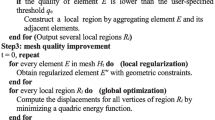Abstract
One of the demands for three dimensional (3D) finite element analyses is the development of an automatic hexahedral mesh generator. For this problem, several methods have been proposed by many researchers. However, reliable automatic hexahedral mesh generation has not been developed at present. In this paper, a new strategy of fully automatic hexahedral mesh generation is proposed. In this strategy, the prerequisite for generating a hexahedral mesh is a quadrilateral surface mesh. From the given surface mesh, combinatorial dual cycles (sheet loops for the whisker-weaving algorithm) are generated to produce a hexahedral mesh. Since generating a good quality hexahedral mesh does not depend only on the quality of quadrilaterals of the surface mesh but also on the quality of the sheet loops generated from it, a surface mesh modification method to remove self-intersections from sheet loops is developed. Next, an automatic hexahedral mesh generator by the improved whisker-weaving algorithm is developed in this paper. By creating elements and nodes on 3D real space during the weaving process, it becomes possible to generate a hexahedral mesh with fewer bad-quality elements. Several examples will be presented to show the validity of the proposed mesh generation strategy.

























Similar content being viewed by others
Explore related subjects
Discover the latest articles and news from researchers in related subjects, suggested using machine learning.References
Shephard M, Georges M (1991) Automatic three-dimensional mesh generation by the finite octree technique. Int J Numer Methods Eng 32:709–749
Lo SH (1991) Volume discretization into tetrahedra-II. 3D triangulation by advancing front approach. Comput Struct 39:501–511
Kettunen L, Forsman K (1995) Tetrahedral mesh generation in convex primitives. Int J Numer Methods Eng 38:99–117
Cook W, Oakes W (1982) Mapping methods for generating three-dimensional meshes. Comput Mech Eng 1:67–72
Miyoshi K, Blacker T (2000) Hexahedral mesh generation using multi-axis cooper algorithm. In: Proc 9th int meshing roundtable
Blacker T (1996) The cooper tool. In: Proc 5th int meshing roundtable, pp 13–29
Lai M, Benzley S, White D (2000) Automated hexahedral mesh generation by generalized multiple source to multiple target sweeping. Int J Numer Methods Eng 49:261–275
Li TS, McKeag R, Armstrong C (1995) Hexahedral meshing using midpoint subdivision and integer programming. Comput Meth Appl Mech Eng 124:171–193
Schneiders R (1996) A grid-based algorithm for the generation of hexahedral element meshes. Eng Comput 12:168–177
Canann S (1991) Plastering and optismoothing: new approaches to automated 3D hexahedral mesh generation and mesh smoothing. Ph.D. Dissertation, Brigham Young Univ., Provo
Tautges T, Blacker T, Mitchell S (1996) The whisker-weaving algorithm: a connectivity-based method for constructing all-hexahedral finite element meshes. Int J Numer Methods Eng 39:3327–3349
Kawamura Y, Okura A, Sumi Y (2002) Automatic hexahedral mesh generation based on the whisker-weaving algorithm with refinement technique of element shape (in Japanese). Proc Conf Comput Eng Sci (JSCES) 7:419–422
Staten M, Owen S, Blacker T (2005) Unconstrained paving and plastering: a new idea for all hexahedral mesh generation. In: Proc 14th int meshing roundtable, pp 399–416
Staten M, Kerr R, Owen S, Blacker T (2006) Unconstrained paving and plastering: progress update. In: Proc 15th int meshing roundtable, pp 469–486
Mitchell S (1996) A characterization of the quadrilateral meshes of a surface which admit a compatible hexahedral mesh of the enclosed volume. In: Proc 13th symposium on theoretical aspects of computer science, pp 465–476
Wenjie C, Shinoda J, Hagiwara I (2004) The principle of automatic hexahedral mesh generation and proposal of the method for getting rid of self-intersections of dual cycles (in Japanese). J Jpn Soc Simul Technol 23(3):238–246
Mantyla M (1988) An introduction to solid modeling. Computer Science Press, Rockville
Zhu J, Zienkiewicz OC, Hinton E, Wu J (1991) A new approach to the development of automatic quadrilateral mesh generation. Int J Numer Methods Eng 32:849–866
Blacker T (1991) Paving: a new approach to automated quadrilateral mesh generation. Int J Numer Methods Eng 32:811–847
Kawamura Y, Mu Y, Sumi Y (1999) Development of an automatic quadrilateral mesh generator for the simulation of curved crack growth. Trans JSCES 2:1–6
Folwell N, Mitchell S (1999) Reliable whisker-weaving via curve contraction. Eng Comput 15:292–302
Calvo N, Idelsohm S (2002) All-hexahedral element meshing: automatic elimination of self-intersecting dual lines. Int J Numer Methods Eng 55:1439–1449
Lo S, Lee C (1992) On using meshes of mixed element types in adaptive finite element analysis. Finite Elem Anal Des 11:307–336
Muller-Hannemann M (1998) Hexahedral mesh generation by successive dual cycle elimination. In: Proc 7th international meshing roundtable, pp 379–393
Patran MSC (2001) Reference manual, vol 2. In: Finite element modeling, chap 11, pp 170–192
Freitag L (1997) On combining Laplacian and optimization-based mesh smoothing techniques. Trends in unstructural mesh generation AMD-vol 220. ASME, pp 37–43
Canann S, Tristano J, Staten M (1998) An approach to combined Laplacian and optimization-based smoothing for triangular, quadrilateral, and quad-dominant meshes. In: Proc 7th int meshing roundtable, pp 479–494
Field D (1987) Laplacian smoothing and delaunay triangulations. Commun Appl Numer Meth 4:709–712
Hansbo P (1995) Generalized Laplacian smoothing of unstructured grids. Commun Numer Methods Eng 11:455–464
Tautges J, Mitchell SA (1995) Pillowing doublets: refining a mesh to ensure that faces share at most one edge. In: Proc 4th int meshing roundtable, pp 231–240
Suzuki K, Takahashi S, Shephard J (2005) Practical interior surface generation method for all-hexahedral meshing. In: Proc 14th int meshing roundtable, pp 377–393
Author information
Authors and Affiliations
Corresponding author
Rights and permissions
About this article
Cite this article
Kawamura, Y., Islam, M.S. & Sumi, Y. A strategy of automatic hexahedral mesh generation by using an improved whisker-weaving method with a surface mesh modification procedure. Engineering with Computers 24, 215–229 (2008). https://doi.org/10.1007/s00366-008-0092-3
Received:
Accepted:
Published:
Issue Date:
DOI: https://doi.org/10.1007/s00366-008-0092-3




